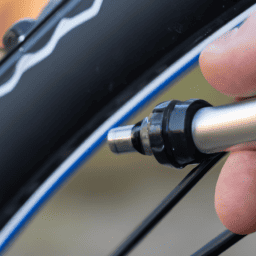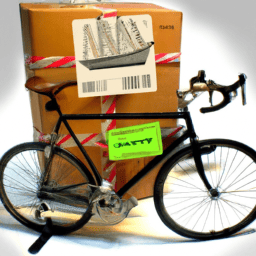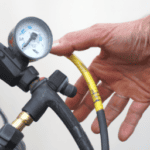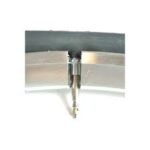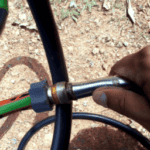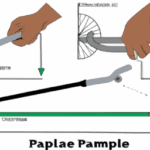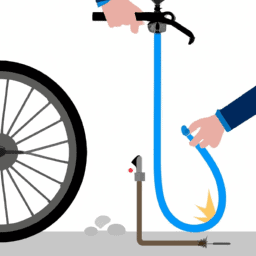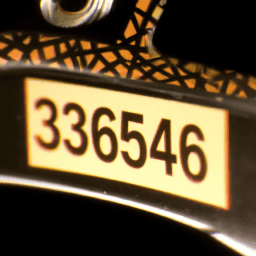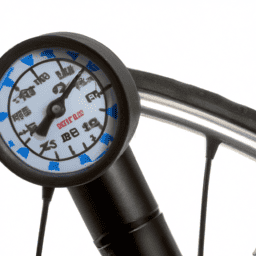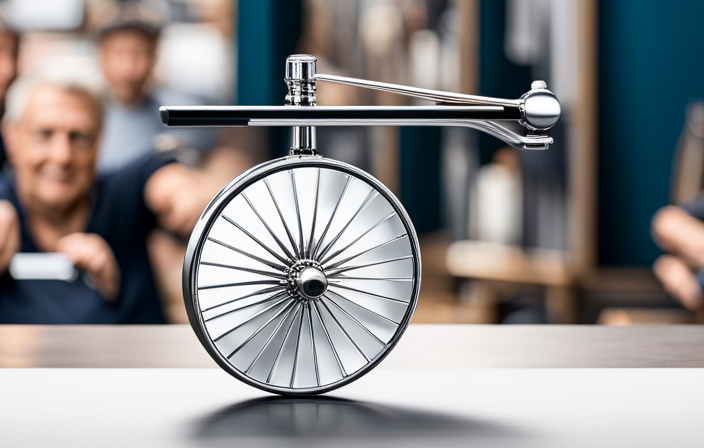As a bike rider, you understand the significance of maintaining your bicycle’s optimal functioning. Among the basic but essential maintenance practices is ensuring your tires are properly inflated to the correct pressure.
However, if you’re new to cycling or have recently switched to a bike with Presta valves, you may be unsure of how to properly inflate your tires. In this article, we’ll guide you through the process of inflating your bicycle tires with Presta valves, so you can ride with confidence and avoid any mishaps on the road.
Before we dive into the specifics of inflating your tires, it’s important to understand the difference between Presta and Schrader valves. Presta valves are typically found on higher-end road bikes and are known for their slender design and ability to hold higher pressures.
Schrader valves, on the other hand, are more commonly found on mountain bikes and are similar in design to the valves found on car tires. By understanding the differences between these two types of valves, you’ll be better equipped to properly inflate your tires and ensure a smooth ride.
So, let’s get started!
Key Takeaways
- Presta valves are commonly found on higher-end road bikes and require a special pump head.
- Regular maintenance is necessary for Presta valves to ensure efficient and reliable inflation.
- Inflation methods can include CO2 cartridges or portable air compressors, but caution should be used and manufacturer’s instructions should be followed.
- Checking tire pressure regularly with a gauge is important to ensure appropriate inflation levels.
Understand the Difference Between Presta and Schrader Valves
Let’s break it down: Presta valves are the thin ones, and Schrader valves are the fat ones.
Presta valves are commonly found on road bikes and high-performance bicycles, while Schrader valves are more commonly found on mountain bikes and other recreational bicycles.
Presta valves have a smaller diameter than Schrader valves and require a special pump head to inflate them. Schrader valves, on the other hand, can be inflated with a variety of pump heads, including those commonly found at gas stations.
In terms of pros and cons, Presta valves are generally considered to be more efficient and reliable than Schrader valves. They are less prone to leaking and are more suitable for high-pressure applications.
However, Presta valves can be more difficult to inflate, especially without the proper pump head. Additionally, Presta valves require regular maintenance to ensure that they are functioning properly. This includes checking the valve core for wear and tear, as well as keeping the valve stem clean and free of debris.
With this in mind, let’s move on to gathering the necessary tools for inflating your bicycle tires with Presta valves.
Gather the Necessary Tools
To properly inflate your bicycle tires with Presta valves, you’ll need to gather the necessary tools.
Firstly, make sure to choose the right pump that’s compatible with Presta valves. If you have a pump that only works with Schrader valves, you’ll need to use an adapter to properly inflate your Presta valve tires.
It’s important to note that using the wrong pump or adapter can damage your valve and cause a flat tire.
Choose the Right Pump
Make sure you’ve got the right pump with a Presta valve head to avoid frustration and ensure a smooth inflation process. There are different types of Presta valves, and each requires a specific pump head. Here are four things to consider when choosing the right pump:
-
Look for a pump with a Presta valve head. This is the only way to inflate a Presta valve without an adapter.
-
Consider using a floor pump with a gauge. This’ll help you inflate your tire to the correct pressure, which is important for optimal performance and safety.
-
Make sure the pump has a secure fit on the valve stem. If the fit’s loose, air will escape, and you won’t be able to inflate the tire.
-
Check the pump’s maximum pressure rating to make sure it can handle the pressure required for your tire.
Using the right pump’ll make the inflation process much easier, but if you don’t have one with a Presta valve head, you can use an adapter if necessary.
Use an Adapter if Necessary
If you find yourself with a pump that doesn’t have the right valve head for your presta valve, don’t worry! You can easily use an adapter to get the job done and avoid any frustration. There are various types of adapters available in the market that allow you to use a pump with a Schrader valve head on your presta valve.
Using an adapter has several benefits for presta valves. Firstly, it enables you to use any pump with a Schrader valve head, which is a common type of valve head found on most pumps. Secondly, it provides a better seal between the pump and the valve, which means that you can inflate your tire more efficiently and with less effort. Lastly, it prevents damage to the valve stem, which can occur if you use a pump with the wrong valve head. So, if you don’t have a pump with a presta valve head, using an adapter is a great solution to inflate your tires with ease.
With your adapter at the ready, you can now prepare your tire and valve for inflation.
Prepare Your Tire and Valve
First, check that your tire is properly seated on the rim and that the valve is straight and perpendicular to the rim surface. This ensures that the valve stem isn’t at an angle, preventing air from entering the tire.
Next, remove the valve cap, which covers the valve and prevents dirt and debris from entering it. This also allows air to flow freely into the tire.
It’s important to prepare your tire and valve before inflating to ensure that you can inflate your tire properly. Once you’ve checked your tire pressure and removed the valve cap, you’re ready to move on to the next step and inflate your tire to the desired pressure.
Inflate Your Tire
Now that you’ve prepared your tire and valve, it’s time to inflate it with the proper pressure. Start by attaching the pump head to the valve, making sure it’s secure.
If you’re using a floor pump, make sure the base is stable on the ground. If you’re using a hand pump, make sure it’s in the locked position.
Begin pumping air into the tire and keep an eye on the pressure gauge. Stop when you reach the recommended tire pressure, which can be found on the sidewall of your tire.
After inflating, check for leaks by listening for any hissing sounds or feeling for any air escaping from the valve or tire. If you detect a leak, release the air, reattach the pump head, and inflate again.
Now that you’ve properly inflated your tire and checked for leaks, it’s time to finish up by securing the valve cap back onto the valve. This will help prevent any dirt or debris from getting inside the valve and potentially causing a leak.
With your tire now properly inflated, you’re ready to hit the road or trail with confidence!
Finish Up
After ensuring your tire is properly inflated and checking for leaks, it’s important to secure the valve cap back onto the valve to prevent any potential damage. Make sure the cap is tightened just enough to prevent air from escaping, but not so tight that it becomes difficult to remove later on.
If the cap is too tight, it can damage the valve and make it difficult to inflate your tire in the future. Common mistakes can be easily avoided with proper care and attention to detail.
One of the most common mistakes is overinflation, which can lead to a blown tire or damage to the rim. To avoid this, use a tire pressure gauge to check the pressure regularly and adjust as necessary.
If you notice any leaks or damage to the valve, try troubleshooting by tightening the valve cap, checking the seal, or replacing the valve altogether. Alternatively, you can use alternative inflation methods such as CO2 cartridges or a portable air compressor.
Just be sure to follow the manufacturer’s instructions carefully and use caution when inflating your tire.
Frequently Asked Questions
What is the recommended tire pressure for a bicycle tire with a presta valve?
Like a well-tuned instrument, your bicycle tire requires proper air pressure for optimal performance. Measuring tools and tire type are factors affecting the recommended tire pressure for a presta valve. Precisely adjust to maximize your ride.
How do you know when your tire has reached the correct pressure?
To know when your tire has reached the correct pressure, use a tire pressure gauge. Over inflation risks include tire damage or even a blowout. Ensure proper pressure for a safe and efficient ride.
Can you use a regular air pump to inflate a tire with a presta valve?
Oh, you’re one of those people who thinks rules don’t apply to you? Sure, go ahead and try to use a regular air pump on a presta valve without adapters. Or, you know, you could use alternative pumps specifically designed for presta valves. Your call.
How often should you check the tire pressure on your bicycle?
It is important to regularly check your bicycle tire pressure to ensure optimal performance and safety. Riding with low tire pressure can result in decreased speed, increased effort, and even accidents. Make it a habit to check your tire pressure before each ride.
What should you do if the valve core on your presta valve becomes loose?
If your presta valve core becomes loose, you should perform valve maintenance by tightening it with a valve core tool. Use a tightening technique that ensures the core is secure, but not overtightened.
Conclusion
Congratulations! You’ve successfully inflated your bicycle tires with Presta valves.
By following the steps outlined in this guide, you’ve gained the knowledge and skills necessary to take care of your tires and ensure a safe and comfortable ride.
Remember, understanding the difference between Presta and Schrader valves is essential before attempting to inflate your tires. Gathering the necessary tools and properly preparing your tire and valve are also crucial steps in the process.
Finally, inflating your tire to the correct pressure and finishing up with a quick check ensures that your ride is smooth and efficient.
Coincidentally, the process of inflating your bike tires can also be a metaphor for life. Just as you must take care of your tires to ensure a safe and enjoyable ride, you must also take care of yourself to live a fulfilling life.
By gathering the necessary tools, preparing yourself for challenges, and pushing yourself to reach the right pressure, you can find success and happiness in all areas of your life.
So go out there, inflate those tires, and enjoy the ride!
